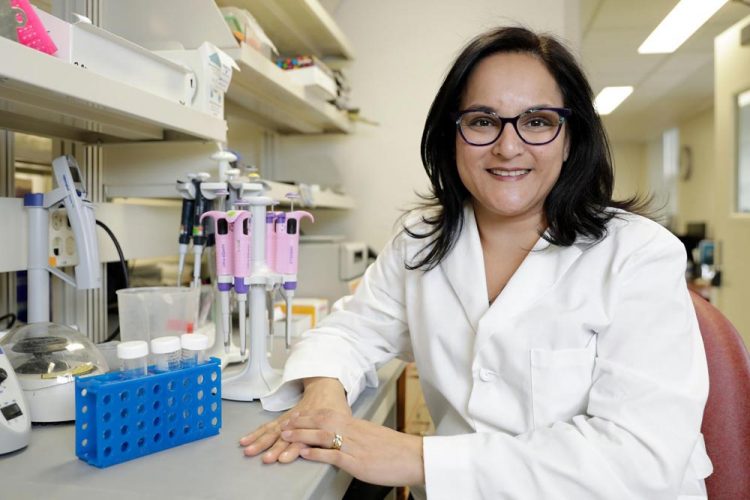A new link between migraines, opioid overuse may be key to treating pain

Amynah Pradhan Credit: UIC/Joshua Clark
About 10% of the world population suffers from migraine headaches, according to the National Institute of Neurological Disorders and Stroke. To alleviate migraine pain, people are commonly treated with opioids. But, while opioid treatment can provide temporary pain relief for episodic migraines, prolonged use can increase the frequency and severity of painful migraines.
Researchers have tried to understand how opioids cause this paradoxical increase in pain for a decade, but the mechanism remained elusive — until now.
Researchers at the University of Illinois at Chicago and colleagues discovered that a peptide — small chains of amino acids that can regulate many behaviors and brain signaling pathways — links together migraine pain and pain induced by opioid overuse.
Their findings are published in the journal Molecular and Cellular Proteomics.
Amynah Pradhan, senior author and UIC associate professor of psychiatry at the College of Medicine said, “Endorphin is an example of a peptide that signals the brain to give a 'runner's high.' However, not all peptides signal for pleasant outcomes. Pituitary adenylate cyclase-activating peptide, or PACAP, is a peptide that can induce migraines in migraine-prone individuals. Because the overuse of opioids can lead to worse migraines, we wanted to determine whether opioid-induced pain changed the amounts of peptides in the brain and understand if pain from migraines and opioid overuse shared any peptides in common.”
To study these peptides, Pradhan and her colleagues, including researchers at the University of Illinois at Urbana-Champaign, developed two animal models: migraine pain and opioid overuse pain, both in mouse models. Using mass spectrometry to identify peptides and their quantities in the animal samples, they found only a few peptides were altered in both models. PACAP was one of them.
“We were amazed to find PACAP in both models,” Pradhan said. “This study validates prior work on PACAP's role in migraine pain and, more importantly, is the first to identify PACAP as a factor in opioid-induced pain. It is also significant that the PACAP increase was seen in major pain processing sites of the brain, in both models.
“These findings provide strong evidence that PACAP is involved in both migraine and opioid-overuse pain. We finally understand a mechanism through which opioids may exacerbate migraines — through PACAP.”
Pradhan said these findings can inform the development of real-world treatments.
“Companies are developing therapies for migraine pain right now,” Pradhan said. “There are clinical trials underway to test antibodies targeting PACAP and a PACAP-binding receptor. Based on our data, these therapies may be extremely effective for people that have used opioids to treat their migraines.”
This research may benefit people suffering from non-migraine pain as well, she said, as people with chronic pain also experience opioid-induced pain after overuse.
###
Krishna Anapindi, Ning Yang, Elena Romanova, Stanislav Rubakhin and Jonathan Sweedler from the University of Illinois at Urbana-Champaign, and Alycia Tipton, Isaac Dripps and Zoie Sheets from the University of Illinois at Chicago were co-authors on this paper.
This research was funded in part by the National Institute on Drug Abuse (P30 DA018310, DA040688).
Media Contact
All latest news from the category: Health and Medicine
This subject area encompasses research and studies in the field of human medicine.
Among the wide-ranging list of topics covered here are anesthesiology, anatomy, surgery, human genetics, hygiene and environmental medicine, internal medicine, neurology, pharmacology, physiology, urology and dental medicine.
Newest articles

Zap Energy achieves 37-million-degree temperatures in a compact device
New publication reports record electron temperatures for a small-scale, sheared-flow-stabilized Z-pinch fusion device. In the nine decades since humans first produced fusion reactions, only a few fusion technologies have demonstrated…

Innovative microscopy demystifies metabolism of Alzheimer’s
Researchers at UC San Diego have deployed state-of-the art imaging techniques to discover the metabolism driving Alzheimer’s disease; results suggest new treatment strategies. Alzheimer’s disease causes significant problems with memory,…

A cause of immunodeficiency identified
After stroke and heart attack: Every year, between 250,000 and 300,000 people in Germany suffer from a stroke or heart attack. These patients suffer immune disturbances and are very frequently…





















